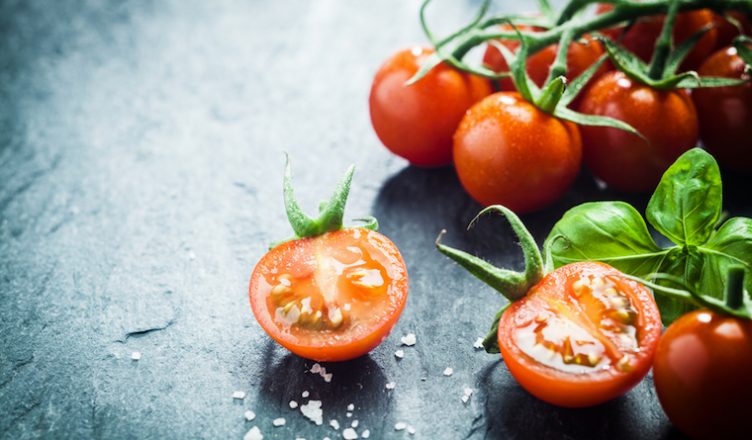You can’t beat the flavour of home-grown tomatoes straight from the vine – and they’re so easy to sow & grow! Simply choose your favourites from the huge range of tomato seeds and tomato plants on offer, and follow our instructions to make sure you enjoy a bountiful and succulent, sun-drenched harvest. Here are some top tips on how to plant, sow & grow tomato seeds.Tomatoes are an easy, satisfying crop
How do you grow tomatoes from seed?
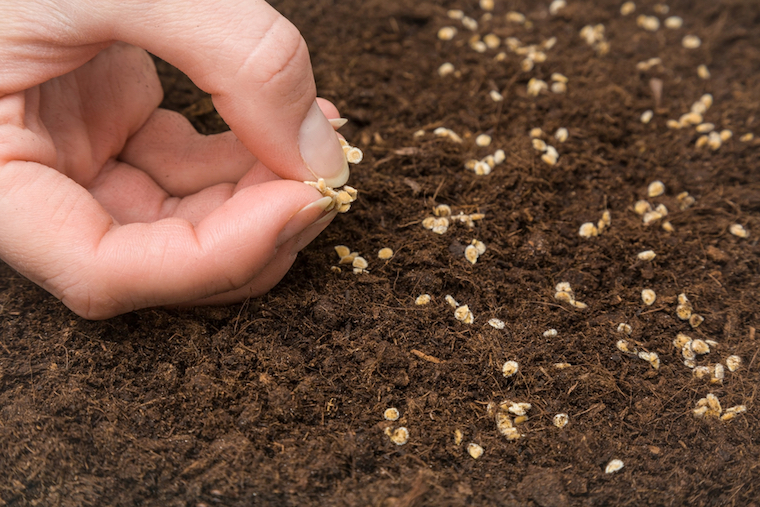
To get them ready for the summer salads, sow your seeds in March or April.
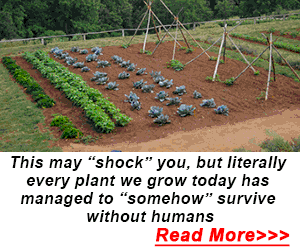
Sow your tomato seeds in March or April, approximately 6-8 weeks before the final frost of the winter, or earlier if you’re growing your tomatoes in a greenhouse. Sprinkle the seed thinly onto good quality seed compost. Cover with 1.5mm of compost and water lightly with a fine-rose watering can.
If you’re only growing a few plants, sow two seeds into a 7.5cm (3″) pot. Keep the compost moist, but be careful not to over-water as wet conditions can encourage “damping-off” disease, and other mould problems. At a temperature of 21 degrees celsius, tomato seeds usually germinate in 7 to 14 days. After germination remove the smaller plant.
Pot on the tomato seedlings as soon as they’re big enough to handle. Hold the plants by the leaves, taking care not to touch the stems, and transplant them into 7.5cm (3in) pots. Protect the plants from frost, cold winds, and draughts which might kill them.
What variety of tomato should you choose?
If you’re still undecided, take a look at our tomato selector guide to help you choose which tomato varieties to grow.
How much water do tomato plants need?
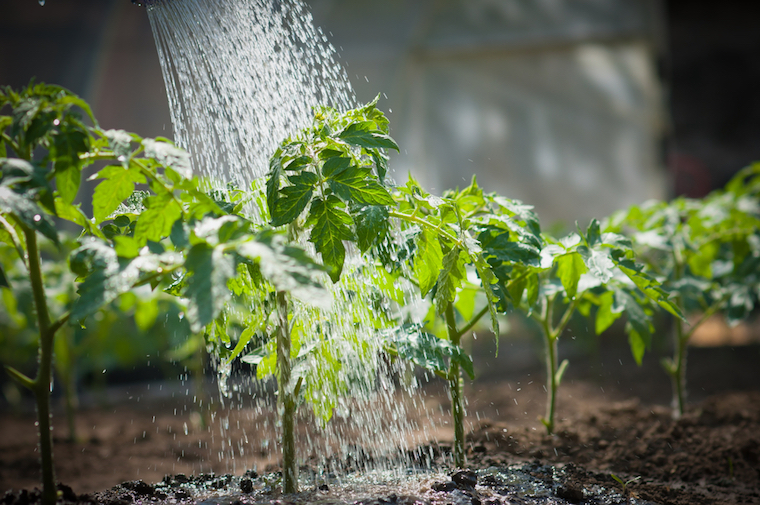
To produce a bountiful crop, tomatoes need regular and plentiful watering.
Tomato plants need a lot of water and feed if they’re to produce a bountiful crop. For best results, water little and often. Some gardeners leave a few filled watering cans to warm in their greenhouse so the water is not shockingly cold from the tap or water butt.
Some people claim that watering at exactly the same time each day makes a difference to the quality of the crop! Feed your tomatoes with a general liquid feed until the first truss has formed then alternate with a high potash feed to encourage more flowers and fruit.
How do you grow tomatoes in a greenhouse?
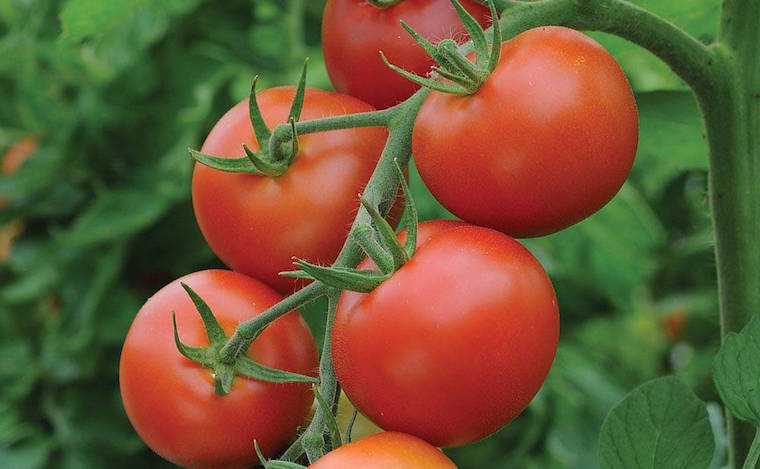
Varieties like the Moneymaker tomato thrive in greenhouses.

Growing tomatoes indoors produces an early crop, especially if you choose recommended varieties like ‘Sungold’, ‘Money Maker’ or ‘Country Taste’. If you’re after tomatoes to make soups and sauces then tomato ‘Roma VF’ is the variety for you. Sow in 7.5cm (3″) pots from February onwards, according to the instructions on the seed packet.
Plant the young plants when they are about 15-20cm (6-8in) tall and the flowers of the first truss are just beginning to open. If you’re planting into your greenhouse border, make sure you dig in plenty of garden compost or well-rotted manure during the winter, and do remember to rake in a general purpose fertiliser before planting.
If you’ve used your borders for tomatoes before, it’s best to change the soil before growing them again, or soil pests and root diseases can be a problem. Growing tomatoes in pots or a grow bag? Remember they’ll need a lot more water and care.
Plant your tomatoes about 45cm (18in) apart, leaving 75cm (30in) between rows, and if you’re planting into a grow bag, limit yourself to two plants per bag. Tomatoes prefer a temperature of 21 – 24C (70 – 75F) and will perform poorly at temperatures above 27C (81F) or below 16C (61F). Make sure you ventilate the greenhouse regularly to deter pests and diseases.
How do you grow tomatoes outside?
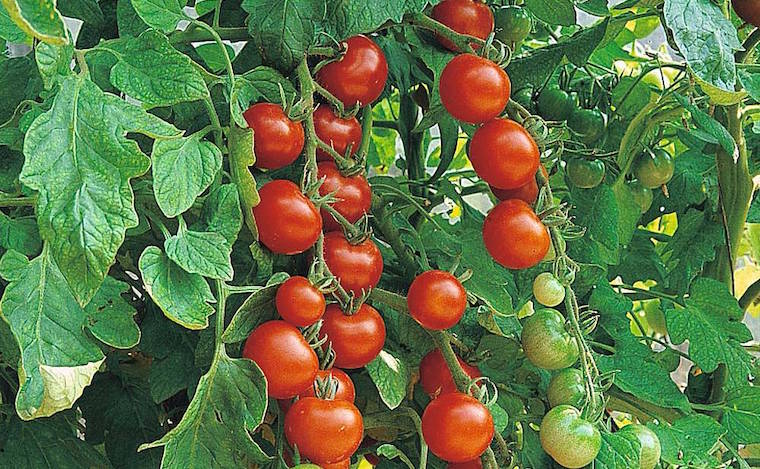
When using hanging baskets, use tomatoes that are known to flourish outdoors, like âGardener’s Delight’.
For best results, choose trusted favourites like ‘Gardener’s Delight’, ‘Money Maker’ or ‘Sweet Olive’. Alternatively if you’re growing your tomatoes in hanging baskets, go for varieties like ‘Cherry Cascade’ or ‘Tasty Tumbler’.
Wait until approximately 6-8 weeks before the last frost is forecast and sow as directed on the seed packet in 7.5cm (3in) pots. It’s time to plant out the young vines when they’re about 15-20cm (6-8in) tall, the flowers of the first truss are just beginning to open, and the risk of frost has passed.
If you’re planting into the ground, make sure you dig in plenty of garden compost or manure during the winter, and just before planting, rake in a general purpose fertiliser. Tomatoes are hungry plants!
Plant your tomatoes about 45cm (18 in) apart, leaving 75cm (30in) between the rows. If you’re growing them in grow bags, limit the number of plants to two, and do remember they’ll need extra watering and care.
To save space, grow your outdoor tomatoes in hanging baskets, or upside down. Simply plant a young tomato plant through a hole in the bottom of a bucket or similar hanging container, and fill the container with multi-purpose compost. Suspend the bucket from a bracket and allow the plant to dangle beneath it.
How do you train tomato plants?
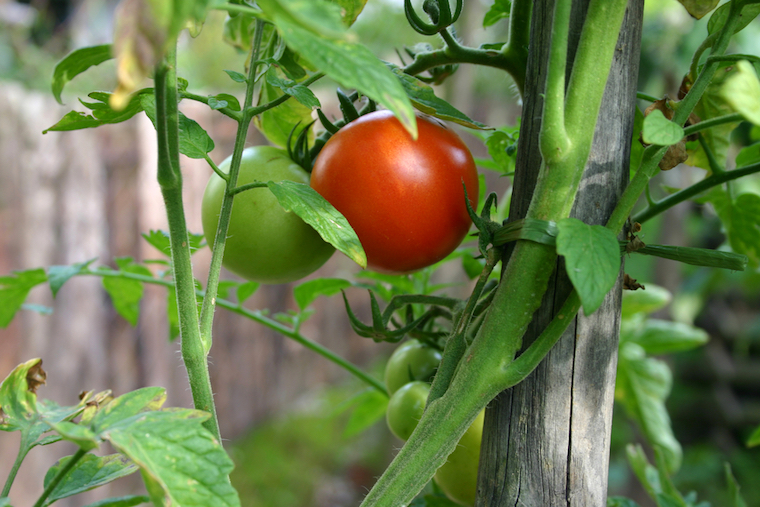
To ensure healthy tomato growth, training them to rely on a support is crucial.
How you train your tomato vines depends whether you opt for cordon/indeterminate, semi-determinate, or determinate varieties:
- Cordon/indeterminate: The most common tomatoes, these single stemmed plants with the side shoots removed grow very tall, sometimes reaching 2.5m.
- Semi-determinate: Similar to indeterminate varieties (grown as cordons) but producing shorter plants.
- Bush/Determinate: Stop growing sooner than indeterminate varieties with the stem ending in a fruit truss. They are referred to as ‘bush’ and ‘dwarf’ types, and are suitable for hanging baskets. They don’t require any pruning.
With indeterminate and semi-determinate varieties (cordons), tie the plant to a support as it grows. Pinching out the side shoots as they develop concentrates the plant’s energy into producing fruit. When the cordon reaches the top of its support, cut out the tip of the main stem two leaves above the top flower truss.
For the best quality fruit it’s best to limit the number of fruit trusses to six per plant. If the vine doesn’t reach the top of its support by late summer, cut out the main tip anyway to give the remaining fruits time to ripen.
Determinate varieties (bush/dwarf types) don’t need pruning or training and happily sprawl along the ground or around the pot they’re growing in. Determinate varieties can stop flower production after several trusses, but you can encourage continued upward growth by training up the topmost side shoot.
When should you harvest tomatoes?
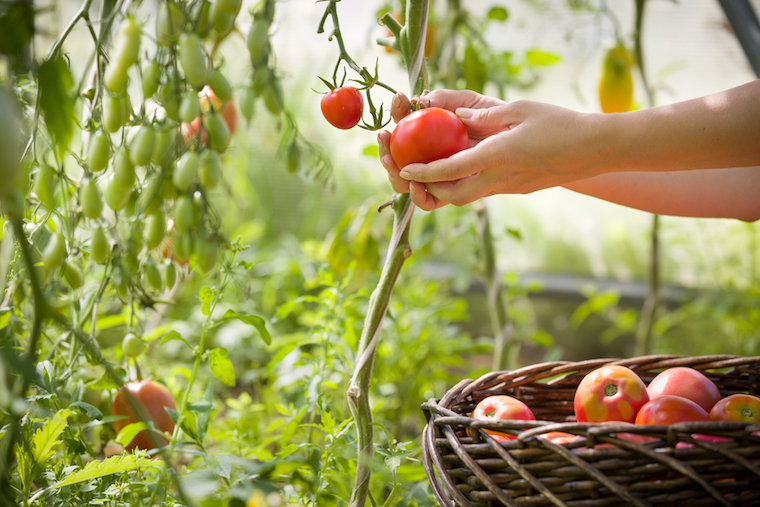
The yummiest part of planting and growing tomatoes is definitely the harvesting.
Start picking your tomatoes as the fruits ripen and gain full colour. When frost threatens at the end of the season, lift any plants with unripe fruit on them and hang them upside down under cover. Tomatoes can be successfully frozen if you find you have a glut.
Common problems with tomato plants
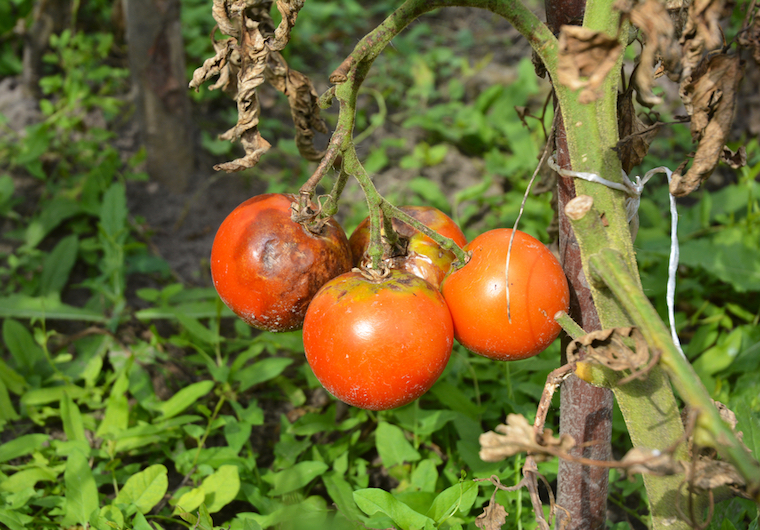
Like potatoes, tomatoes get blight. Make sure you take the right precautions when growing.
Tomato blight
A common problem caused by wet weather, particularly with outdoor plants, tomato blight spreads fast, leaving telltale brown patches all over the plant. Not only does blight kill vines, it also rots the fruit. How to stop blight? Grow blight resistant tomato varieties or spray Bordeaux Mixture on your plants early in the summer.
Fruit problems
Irregular watering, or too much water too late in the growth cycle causes fruiting problems like:
- Blossom End Rot: Dark patch at the base of the fruit, more common if the plant is grown in a grow bag.
- Blossom Drop: Flower bud falls off.
- Dry Set: Fruitlet growth stops when the fruit is the size of a match head.
- Splitting fruit
The key to a healthy crop of tomatoes is regular, even watering, delivered to the base of the plant. Too much water too late tends to be the problem in most cases, especially with plants grown in pots and grow bags.
Too much direct sunlight can also damage your crop. Tomatoes need high light intensity to grow well, but too much can cause blotches, scalds or spots on the developing fruit. ‘Greenback’ is a common problem caused by too much sunlight, leaving the ripe fruit with a hard green area on its ‘shoulder’.
If this is a problem increase the potassium in your plants’ feeding regime and use fleece or shading as a cover in the hottest part of the day. It may also help to use resistant varieties like ‘Alicante’ or ‘Craigella’.
Insect pests
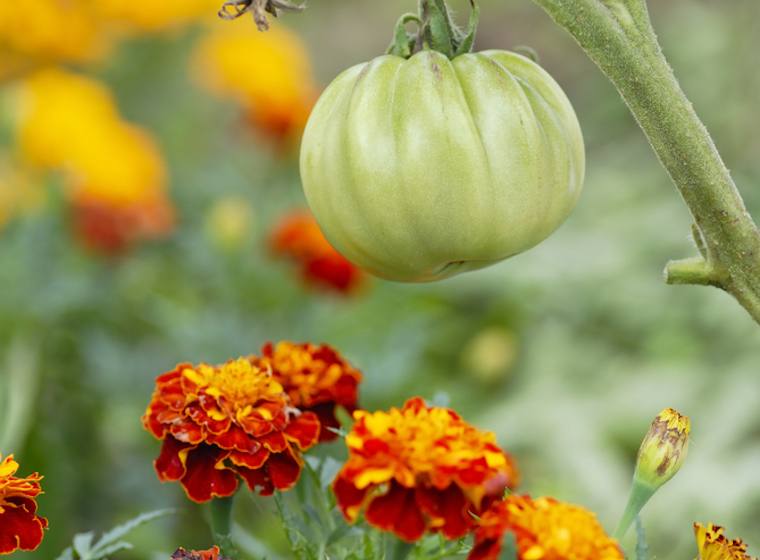
Consider companion planting marigolds with tomatoes as a whitefly repellent,
Look out for green and white fly because both can spread viruses. Spray your vines with a recommended insecticide as soon as you notice pests. Organic gardeners might prefer to plant marigold varieties like ‘Tomato Growing Secret’ nearby which attract beneficial insects that eat pests.
Leaf problems
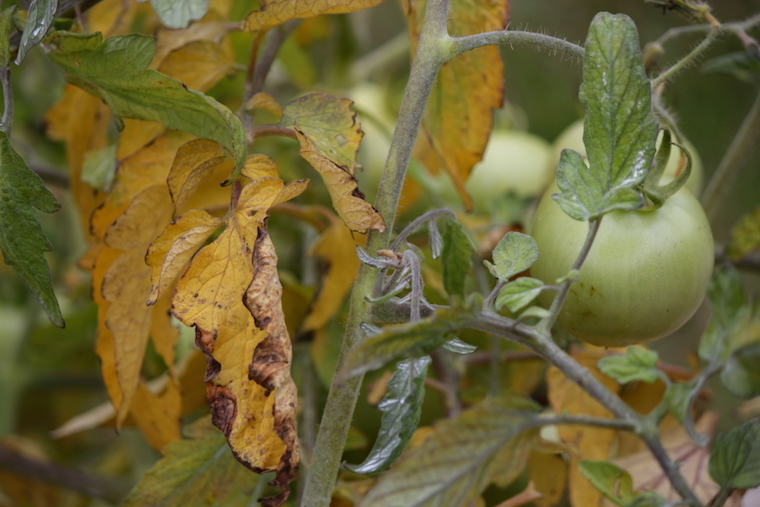
Keep an eye on your leaves; these could reveal ill health for your tomatoes.
Curling leaves. May be caused by aphids sucking the sap from them, but if there’s no sign of insects the most likely culprit is cold night-time temperatures (more noticeable in early summer). If this is the case, it’s nothing to worry about.
Mosaic patterns, streaks or distorted leaf surfaces. Your tomatoes may have a virus, in which case your best bet is to remove and destroy them before the problem spreads. Always disinfect tools, boots, and gloves after handling diseased plants.
Leaf yellowing starting on older leaves and moving upwards. The problem could be a magnesium deficiency which is easy to remedy with a special magnesium feed.
For a visual tomato growing guide, check out this ‘How to grow tomato seeds video.
Growing tomatoes is such a satisfying way to get ingredients for your soups, salads, sandwiches and more. If you’ve never tried, give it a go – and if you’re a seasoned hand, which new varieties should you try?
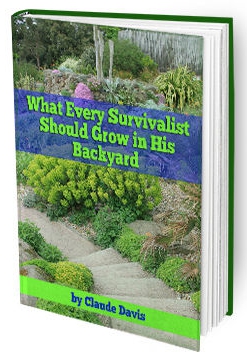
source : Sue Sanderson

